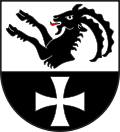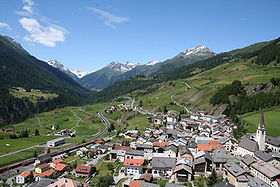Ardez
| Ardez | ||
|---|---|---|
| State : |
|
|
| Canton : |
|
|
| Region : | Engiadina Bassa / Val Müstair | |
| Political community : | Scuol | |
| Postal code : | 7546 | |
| former BFS no. : | 3741 | |
| Coordinates : | 810 857 / 184136 | |
| Height : | 1467 m above sea level M. | |
| Area : | 61.39 km² | |
| Residents: | 425 (December 31, 2013) | |
| Population density : | 7 inhabitants per km² | |
| Website: | www.ardez.ch | |
|
Ardez |
||
| map | ||
|
|
||
Ardez ( ; German obsolete: Steinsberg) is a village in the municipality of Scuol in the Sur Tasna district in the Inn district of the Swiss canton of Graubünden .
Until December 31, 2014, Ardez was an independent political municipality . On January 1, 2015, Ardez was incorporated into the municipality of Scuol with the four municipalities Ftan , Guarda , Sent and Tarasp .
coat of arms
Blazon : Divided by silver (white) and black, in silver half a black, red armed ibex , in black a silver paw cross
Coat of arms after a 19th century seal .
geography

Ardez is located on the left side of the valley of the Lower Engadine above the Inn . The fractions Sur En (right side of the valley) and Bos-cha (between Ardez and Guarda) belong to Ardez. The former municipality extends from the Austrian border in the north ( Gemsspitze, Hintere Jamspitze ) to the national park border in the south ( Piz Sampuoir . The highest point of the former municipality is Piz Plavna Dadaint , 3166 m). The Ardez area includes the Val Nuna and Val Sampuoir side valleys to the south of the Inn and the Val Tasna on the northern side of the valley. The neighboring communities are Zernez and the Austrian Galtür . Around 1900, the Ardezer soil reached into the Montafon ( Vorarlberg ) and into the Paznaun ( Tyrol ).
geology
The Ardez landscape is nestled between the crystalline masses of the Silvretta and the Lower Engadine Dolomites . Here crystalline and limestone / shale areas border one another. The hilly terrace east of Steinsberg Castle consists mainly of old Tasna crystalline. Trias dolomite and the Lias rocks of Steinsberg Castle lie above it . To the west of the village, Neokom sand limestone of the younger Cretaceous levels (road to Bos-cha) are superimposed.
population
The population development was fairly stable. In 1780 there were 531 inhabitants, in 1900 612. There was a high point in 1910 due to the construction of the railway with 1005 inhabitants and a low in 1980 with 383 inhabitants.
languages
The Graubünden Romanesque dialect Vallader has remained the language of a large majority of the population to this day. It is also supported by the community and the school. This is why 85% of the population in 1990 and 89% in 2000 stated that they understood Romansh. Until 1900 the community was almost monolingual (1880 94%, 1900 94%). This proportion has decreased since then, but only marginally until 1980 (1941 84%, 1980 83%). The proportion of German speakers has increased significantly since the 1980s.
| Languages in Ardez | ||||||
| languages | 1980 census | 1990 census | 2000 census | |||
| number | proportion of | number | proportion of | number | proportion of | |
| German | 50 | 13.05% | 78 | 19.85% | 81 | 20.20% |
| Romansh | 316 | 82.51% | 288 | 73.28% | 296 | 73.82% |
| Italian | 17th | 4.44% | 26th | 6.62% | 12 | 2.99% |
| Residents | 383 | 100% | 393 | 100% | 401 | 100% |
Religions and denominations
The citizens of Ardez converted to Protestant teaching in 1538 .
Origin and nationality
Of the 431 residents at the end of 2005, 394 (= 91.42%) were Swiss citizens.
history
There were prehistoric finds at Bos-cha ( bowl stones ) and at Chanoua (ceramics from the Fritzens-Sanzeno culture ). According to the excavations, Suotchastè was settled from the late Bronze Age ( Laugen-Melaun culture , 13th to 6th century BC) to the younger Iron Age (Fritzens-Sanzeno, 5th to 1st century BC). Place names and a written find that can be assigned to the Fritzens-Sanzeno culture suggest that the authors of the corresponding artefacts should be viewed as Raetians in the sense of ancient sources. 15 BC They were subjugated by the stepsons Drusus and Tiberius of the Emperor Augustus and in the 1st century AD they were incorporated into the Roman province of Raetia . Roman found objects in Ardez also testify to this.
Ardez was first mentioned in the Carolingian land register around the year 900 . The construction of the castle Steinberg probably falls within the period of the Great Charles . There is evidence that the Lords de Ardetz lived from 1161 to 1310. In 1209, the Chur bishop Reinher von Torre bought the castle. Steinsberg was initially a church fort (Luziusstein; Church of St. Luzi on the castle hill) and from the 12th century a feudal seat. To protect rights and freedoms, the population founded the church association in Zernez in 1367 . During the Swabian War (Engadin War), the Austrians destroyed the village of Ardez and the castle in 1499.
The conversion to the Reformation took place in 1538. In addition to Ardez, Guarda, Lavin, Susch and Galtür also belonged to the old parish of Ardez with baptismal and burial rights . The residents of Galtür buried their dead in the Ardez cemetery. In winter, when the Futschöl Pass was not accessible, they buried the dead in the snow and brought them to Ardez in spring.
In the 16th century, the Lower Engadine flag was kept in Ardez. The municipalities had a high degree of sovereignty. When the lords ( magnates ) assumed too much power, the farmers in the communities took up arms and flags ("Fähnlilupf") to ensure that a legal process restored fair conditions.
In 1622 the Protestant Ardez was razed to the ground by the Catholic-Austrian general Alois Baldiron . In 1652 the Ardez bought themselves off from Austria. From 1854 to 2014 Ardez was a municipality.
In 1975, Ardez was selected as a pilot community for the European Year for the Preservation of Monuments together with Corippo , Murten and Martigny as a model village with exemplary restoration of typical Engadine houses ("Réalisation Exemplaire").
Culture and sights
In the tradition of nicknames for the Engadine villages , the Ardezer la bescha , in German: "the sheep".
The festival of Babania is celebrated on the first Saturday in January .
- Evangelical Church , built 1576–1577, previous building first mentioned in the 12th century
- Reformed branch church
- The village image has remained almost unchanged since 1622 with many Engadine houses : House Könz, house Jacob Simon Könz, house Swizer, house with painted facade
- Tuor Planta-Vonzun (La Praschun = cage tower) 13th century, residential tower of the Planta family and later Vonzun (in the southern part of the village), finally a district prison and shepherd's accommodation
- Ruins of Steinsberg Castle
- Former Von Planta House, now the seat of the Not Vital Foundation
- Foura Chagnoula , a cave that was formerly a pet cemetery
- Ruins of the passer-by house and post office building on the old road to Ftan . It was the first time in the 9th century Carolingian Urbar as fiscal tavern / tavern in "Ardezis" at the former road connecting Via imperiala Como - mentioned Tyrol.
- former residential tower of the Scheck von Ardez family
Economy and Infrastructure
In the 16th century the Ardez had developed a distribution system for their alpine farming. Groups of neighboring houses shared an alp. Every seven years the number of Alpstosses per district was adjusted to prevent overgrazing. Every 28 years the Alps were redistributed among the quarters.
In 2015 there were still thirteen farms, several of which are organic farms with suckler cows or sheep. Milk, meat and barley were produced.
The service sector consists of an architecture office, two hotels, three restaurants, a VOLG village shop, a shop for sheep products and a number of holiday apartments. The craft businesses also include those that manufacture leather gloves and sheep's wool jackets.
Ardez is the starting point for many hikes in the area. The closest ski areas are in Ftan and on Motta Naluns above Scuol , which is about 10 kilometers from Ardez.
Ardez is on the Bever-Scuol-Tarasp line of the Rhaetian Railway (RhB) and on the main road 27 .
Personalities
- Representatives of the Ardez families Planta-Wildenberg-Steinsberg , Cazin , Gulfin and Von Zun held high offices ( Podestà ) in Veltlin and Chiavenna .
- Rudolf Alex von Planta , founder of the Plantahof agricultural school in Landquart
- Rudolf Niculin Bezzola (1917–2011), reformed pastor
- Robert Cantieni (1873–1954), he composed the Engadine hymn Chara lingua da la mamma in Ardez
- Oscar Nussio (born July 31, 1899 in Ardez, † May 15, 1976 in Greifensee ) (town of Brusio ), painter, wood sculptor
- Jon Andri Tgetgel (* 1926), civil engineer and general manager
- Reto Mengiardi (* 1939), lawyer, notary, government councilor in the canton of Graubünden 1979–1990
- Nevin Galmarini (* 1986), professional snowboarder and Olympic champion
photos
Sust Chanoua on the old mule track
literature
- Erwin Poeschel : The art monuments of the canton of Graubünden III. The valley communities Räzünser Boden, Domleschg, Heinzenberg, Oberhalbstein, Upper and Lower Engadine. (= Art Monuments of Switzerland. Volume 11). Edited by the Society for Swiss Art History GSK. Bern 1940. DNB 760079625 .
- Jon Claglüna: Ardez. Church Chronicle. 4th enlarged edition. Self-published, Chesa Solena / Pontresina 1985.
- Report on the realization exemplaire Ardez. 1975-1985. Pro Ardez Foundation, 1986.
- Anna-Maria Deplazes-Häfliger: The check in the Engadine and Vinschgau. History of a noble family in the late Middle Ages. Sources and research on the history of Graubünden, Volume 16, Kommissionsverlag Desertina, Chur 2006, ISBN 978-3-85637-322-1 .
- Jürg Wirth: Your holiday resort introduces itself: Ardez. Gammeter, St. Moritz and Scuol 2015
Web links
- Official website of the municipality of Ardez
- Paul Eugen Grimm: Ardez. In: Historical Lexicon of Switzerland .
Individual evidence
- ↑ Thanks to the merger, Scuol is the largest Swiss municipality. In: SWI swissinfo.ch. Retrieved January 13, 2016 .
- ↑ Location of the Ruina Chanoua: 46 ° 46 ′ 52.3 ″ N , 10 ° 12 ′ 50.6 ″ E
- ↑ See: Stefan Schumacher: The Rhaetian inscriptions. History and current state of research (= Innsbruck contributions to cultural studies. Special issue 121 = Archaeolingua. 2). 2nd, expanded edition. Innsbruck Society for the Care of the Humanities, Innsbruck 2004, ISBN 3-85124-155-X , p. 13 and others
- ^ Reformed branch church
- ^ House of Könz
- ↑ Jacob Simon Könz's house
- ↑ Swizer house
- ↑ House with facade painting
- ↑ Tuor Vonzun (La Praschun)
- ↑ Description and pictures on the website of the architect Duri Vital. Retrieved August 2, 2011.
- ↑ Jürg Wirth: Your holiday resort introduces itself: Ardez. Gammeter, St. Moritz and Scuol 2015.
- ^ Oskar Nussio. In: Sikart , accessed January 19, 2016.
- ↑ Jérôme Guisolan: Tgetgel, Jon Andri. In: Historical Lexicon of Switzerland .










